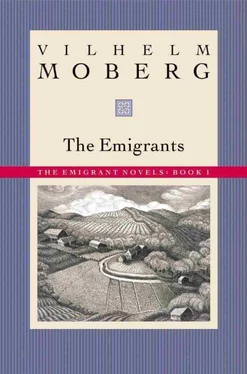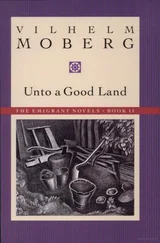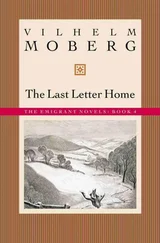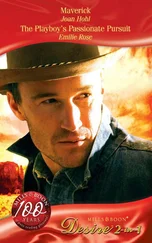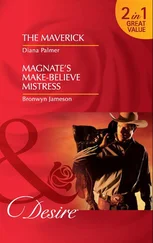Vilhelm Moberg - The Emigrants
Здесь есть возможность читать онлайн «Vilhelm Moberg - The Emigrants» весь текст электронной книги совершенно бесплатно (целиком полную версию без сокращений). В некоторых случаях можно слушать аудио, скачать через торрент в формате fb2 и присутствует краткое содержание. Год выпуска: 1995, Издательство: Minnesota Historical Society Press, Жанр: Классическая проза, на английском языке. Описание произведения, (предисловие) а так же отзывы посетителей доступны на портале библиотеки ЛибКат.
- Название:The Emigrants
- Автор:
- Издательство:Minnesota Historical Society Press
- Жанр:
- Год:1995
- ISBN:нет данных
- Рейтинг книги:3 / 5. Голосов: 1
-
Избранное:Добавить в избранное
- Отзывы:
-
Ваша оценка:
- 60
- 1
- 2
- 3
- 4
- 5
The Emigrants: краткое содержание, описание и аннотация
Предлагаем к чтению аннотацию, описание, краткое содержание или предисловие (зависит от того, что написал сам автор книги «The Emigrants»). Если вы не нашли необходимую информацию о книге — напишите в комментариях, мы постараемся отыскать её.
The Emigrants — читать онлайн бесплатно полную книгу (весь текст) целиком
Ниже представлен текст книги, разбитый по страницам. Система сохранения места последней прочитанной страницы, позволяет с удобством читать онлайн бесплатно книгу «The Emigrants», без необходимости каждый раз заново искать на чём Вы остановились. Поставьте закладку, и сможете в любой момент перейти на страницу, на которой закончили чтение.
Интервал:
Закладка:
Moberg strove to debunk the old heroic myths of Swedish history. But in his tales of the immigrants to Minnesota, he succeeded in his own right in creating a significant popular image. The figures of Karl Oskar and Kristina, the ultimate commonfolk, speak so powerfully to our imagination that they assume a dimension larger than life. Like many other contrasts in his life, this ironic twist would have hit home with Vilhelm Moberg and appealed to his literary sensibility.
Moberg’s writing style has been a subject of discussion since the 1960s when critic Gunnar Brandell denied him a place among the great creative artists of modern Swedish literature. According to Brandell, Moberg wrote a solid everyday prose that did not adequately express shades of difference or depict characters in sufficient depth. Moberg lacked “lyrical resources,” Brandell concluded. 19
Since that time several writers have defended Moberg’s writing style. Gunnar Heldén pointed out Moberg’s strengths in dealing with three central motifs in classic lyricism: nature, love, and death. 20Sven Delblanc described Moberg’s prose style as en poesi i sak, that is, a style that pays steady attention to small details, thus creating a harmony and poetry of everyday life without reliance on the neat turning of phrases or on striking images. 21Finally, Philip Holmes explained Moberg’s use of alliteration, phrase-pairs, and repetition in his prose. These devices allowed Moberg to slow his narrative tempo and to strive “for clarity and fullness of expression.” 22
Holmes described the Old Testament and the medieval Swedish laws as major influences on Moberg’s writing style. Moberg strove in his prose to produce the thought patterns of rural people from the nineteenth century. Although unlettered, these people were confronted with and forced to sort out a new world of impressions and complicated emotions. Moberg’s task was to give a realistic voice to his characters. His success in finding this voice speaks for his creativity.
Roger McKnight
Gustavus Adolphus College
NOTES
1. Magnus von Platen, Den unge Vilhelm Moberg. En levnadsteckning (Stockholm: Bonniers, 1978), 310.
2. Vilhelm Moberg, “Där jag sprang barfota,” Berättelser ur min levnad (Stockholm: Bonniers, 1968), 29–46.
3. Von Platen, Den unge Vilhelm Moberg, 9.
4. Moberg, “Från kolbitar till skrivmaskin,” Berättelser ur min levnad, 119.
5. Moberg, “Romanen om utvandrarromanen,” Berättelser ur min levnad, 292.
6. Moberg, “Romanen om utvandrarromanen,” 293, 298.
7. Moberg, “Romanen om utvandrarromanen,” 294. For similar comments in English, see: Moberg, “Why I Wrote the Novel About Swedish Emigrants,” Swedish Pioneer Historical Quarterly 17 (Apr. 1966): 63.
8. Gunnar Eidevall, Vilhelm Mobergs emigrantepos (Stockholm: Norstedts, 1974), 19–20.
9. For discussions of Moberg’s research methods, see Philip Holmes, Vilhelm Moberg (Boston: Twayne, 1980), 110–32; Ingrid Johanson, “Vilhelm Moberg As We Knew Him,” Bulletin of the American Swedish Institute (Minneapolis), no. 11 (1956); Bertil Hulenvik, Utvandrarromanens källor: Förteckning över Vilhelm Mobergs samling av källmaterial, ed. Ulf Beijbom (Växjö: House of Emigrants, 1972).
10. Don Josè [pseud.], “Vilhelm Mobergs amerikabagage nära att gå till Europahjälpen,” Svenska Dagbladet, June 4, 1948, p. 11.
11. Sven Åhman, “Vilhelm Moberg ser på USA,” Nordstjernan, May 26, 1949.
12. Gustaf Lannestock, Vilhelm Moberg i Amerika (Stockholm: Zindermans, 1977), 36. Much of our knowledge of Moberg’s life in America is derived from the two men’s correspondence and from this volume.
13. For works in English detailing Mobergs impressions of America, see Moberg, The Unknown Swedes: A Book About Sweden and America, Past and Present, ed. and trans. Roger McKnight (Carbondale: Southern Illinois University Press, 1988); McKnight, “The New Columbus: Vilhelm Moberg Confronts American Society,” Scandinavian Studies 64 (Summer 1992): 356—88. Moberg expressed many of his opinions in letters to Lannestock; these letters are now in the House of Emigrants in Växjö, Sweden, and are referred to in “The New Columbus.” See also Lannestock, Vilhelm Moberg i Amerika (in Swedish). My comments here and five paragraphs below are based on these works.
14. Moberg, Min svenska historia (Stockholm: Norstedts, 1971), 1:14.
15. Sigvard Mårtensson, Vilhelm Moberg (Stockholm: Bonniers, 1956), 202.
16. Sven Delblanc, “Den omöjliga flykten,” Bonniers litterära magasin 42, no. 6 (Dec. 1973), 267.
17. Rochelle Wright, “Vilhelm Moberg’s Image of America,” (Ph.D. diss., University of Washington, 1975), 34–40.
18. McKnight, “The New Columbus,” 384.
19. Gunnar Brandell, Svensk Litteratur 1900–1950: Realism och Symbolism (Stockholm: Förlaget Örnkrona, 1958), 261.
20. Gunnar Heldén, “Vilhelm Mobergs lyriska resurser,” Emigrationer: En bok till Vilhelm Moberg 20-8-1968 (Stockholm: Bonniers, 1968), 215–29.
21. Delblanc, “Den omöjliga flykten,” 266.
22. Holmes, Vilhelm Moberg, 126.
Introduction to The Emigrants
Begun in Sweden and completed in California, this first volume of the Emigrant Novels appeared in 1949 with the Swedish title Utvandmrna. It was published in English in 1951 as The Emigrants.
Nineteenth-century Swedish emigration to America took place in three principal phases: individual, group, and mass migration. Group emigration was most common between 1845 and 1865 as powerful forces, so-called push factors, led many commoners to abandon Sweden. Typical push factors were famine and religious persecution. Most group emigration consisted of from fifteen to two hundred people who banded together to start farming or religious settlements in America.
Moberg’s first words say that The Emigrants is the tale of one such group. Aside from their general dissatisfaction, the individuals in this group have little in common, however. Instead each person is motivated by a different push factor: crop failure, persecution by the civil authorities, religious dissent, personal problems, social ostracism, and unfair employment practices. In this sense, the group from Ljuder parish represents a convenient imaginative microcosm of one era in Swedish emigration.
While Moberg carefully traced the background of each of the novel’s figures, he left no doubt as to the tale’s main character. Karl Oskar Nilsson has all the potential for material success on the American frontier. He is young, strong, hard-working, and knowledgeable about farming practices. Yet in defying his father and the local authorities in Sweden he becomes a marked man. When he later curses God, Karl Oskar is in disfavor with the Almighty as well.
In Robert and Kristina, Moberg presented foils to Karl Oskar. Robert’s daydreaming and his interest in books contrast to his older brother’s attention to practical detail. Kristina’s attachment to her home in Småland puts her ideas at serious odds with her husband’s firm belief in their American future.
The Emigrants is a tightly woven story that met with immediate success in Sweden and America. Nevertheless troubles surrounded the book in the early years after its publication. A group of conservative Swedish educators, churchmen, and legislators objected to the vulgar language in the novel, especially the expressive idioms used by Ulrika. This group, led by an Uppsala writer named Ebbe Reuterdahl, also charged that Moberg’s novel slandered the good name of Smålandish emigrants.
Читать дальшеИнтервал:
Закладка:
Похожие книги на «The Emigrants»
Представляем Вашему вниманию похожие книги на «The Emigrants» списком для выбора. Мы отобрали схожую по названию и смыслу литературу в надежде предоставить читателям больше вариантов отыскать новые, интересные, ещё непрочитанные произведения.
Обсуждение, отзывы о книге «The Emigrants» и просто собственные мнения читателей. Оставьте ваши комментарии, напишите, что Вы думаете о произведении, его смысле или главных героях. Укажите что конкретно понравилось, а что нет, и почему Вы так считаете.
